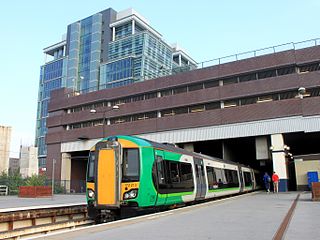
Birmingham Snow Hill, also known as Snow Hill station, is a railway station in Birmingham City Centre. It is one of the three main city-centre stations in Birmingham, along with Birmingham New Street and Birmingham Moor Street.

The Blue Pullmans were luxury trains used from 1960 to 1973 by British Rail. They were the first Pullman diesel multiple units, incorporating several novel features.
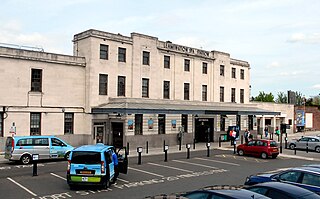
Leamington Spa railway station serves the town of Leamington Spa, in Warwickshire, England. It is situated on Old Warwick Road towards the southern edge of the town centre. It is a major stop on the Chiltern Main Line between London and Birmingham, and is the southern terminus of a branch line to Coventry.

The Chiltern Main Line is a railway line which links London (Marylebone) and Birmingham on a 112-mile (180 km) route via High Wycombe, Bicester, Banbury, Leamington Spa and Solihull in England.

The Hawthorns station is a railway station and tram stop, opened in 1995 in Smethwick, near Birmingham, West Midlands, England. The station shares its name with the local football ground, The Hawthorns, the home of West Bromwich Albion F.C., which it serves. There is a park and ride facility at the tram stop.

Smethwick Galton Bridge is a split-level railway station in Smethwick, West Midlands, England. It is at a point where two railways' lines cross on two levels. It has platforms on both lines, allowing interchange between them. The two low-level platforms serve the Birmingham New Street to Wolverhampton Line, while the two high-level platforms serve the Birmingham Snow Hill to Worcester Line. The high level line passes over the low level line at a right angle on a bridge. West Midlands Railway manages the station and operates most of its services, with others provided by Chiltern Railways and London Northwestern Railway.

The Cambrian Coast Express is an old named passenger train of the Great Western Railway (GWR), and later British Rail, running from London Paddington via Shrewsbury to Aberystwyth and Pwllheli over the Cambrian Line.

Stratford-upon-Avon railway station is the southern terminus of the North Warwickshire Line and Leamington–Stratford line, serving the market town of Stratford-upon-Avon in Warwickshire, England. The station is served by West Midlands Trains (WMT) and Chiltern Railways.

Dorridge railway station serves the large village of Dorridge in the West Midlands of England. The station is served by Chiltern Railways, who manage the station, and also by West Midlands Trains. It is situated 10+1⁄2 miles (16.9 km) south of Birmingham Snow Hill.
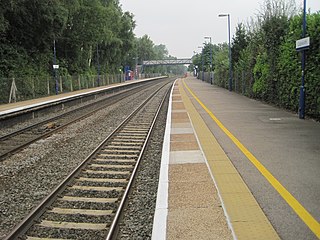
Lapworth railway station serves the village of Kingswood, Warwickshire, near the village of Lapworth from which it takes its name.

Solihull railway station serves the market town of Solihull in the West Midlands of England. The station is served by West Midlands Trains and Chiltern Railways. CrossCountry serve the station occasionally to replace stops at Coventry and Birmingham International during engineering work. Solihull used to have a regular Virgin CrossCountry service to Manchester Piccadilly, Blackpool North and Portsmouth Harbour until 2004, when all services through the station were made to run non-stop between Birmingham and Leamington Spa.

Acocks Green railway station serves the Acocks Green area of Birmingham, in the West Midlands region of England. Pre-nationalisation a GWR station on their main line from London (Paddington) to Birkenhead (Woodside) the station is now served by West Midlands Railway, who manage the station.
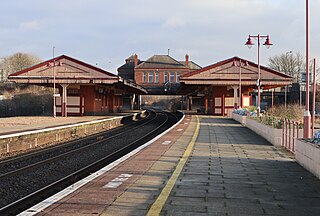
Tyseley railway station serves the district of Tyseley in Birmingham, West Midlands, England. It is at the junction of the lines linking Birmingham with Leamington Spa and Stratford-upon-Avon.

Droitwich Spa railway station serves the town of Droitwich Spa in Worcestershire, England. It is located just to the south-west of Droitwich Spa Junction of the Worcester to Leamington Spa Line and the Worcester to Birmingham New Street line. The station is managed by West Midlands Trains, who also operate all trains serving it.

Pullman trains in Great Britain were mainline luxury railway services that operated with first-class coaches and a steward service, provided by the British Pullman Car Company (PCC) from 1874 until 1962, and then by British Railways from 1962 until 1972. Many named mainline service trains have subsequently used the word 'Pullman' in their titles, but most of these have been normal trains with increased first-class accommodation. Since 1982 however, some railtours have been operated by companies using Pullman coaches dating from the 1920s to 1950s to recreate the ambience of the heyday of Pullman travel.

The Birmingham Snow Hill to Wolverhampton Low Level Line was part of the Great Western Railway's London Paddington to Birkenhead Woodside route. As the name suggests, it ran between Birmingham Snow Hill and Wolverhampton Low Level in England. The line was dual-gauged, both 7 ft 1⁄4 in and 4 ft 8+1⁄2 instandard gauge.
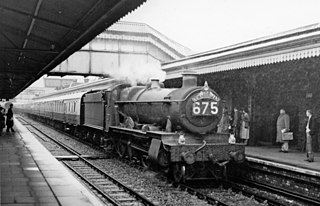
The Cornishman is a British express passenger train to Penzance in Cornwall. From its inception in the 19th century until before World War II it originated at London Paddington. Under British Railways the name was applied to a different service, starting variously from Wolverhampton, Leeds or Bradford. In 2006, First Great Western, now Great Western Railway, reintroduced the named service which now runs once per day from Monday to Saturday in both directions.

The Snow Hill Lines is the collective name for the railway lines running through Birmingham Snow Hill, and Birmingham Moor Street stations in Birmingham, United Kingdom. They form an important part of the suburban rail network of Birmingham, Warwickshire and Worcestershire. All other lines to/through Birmingham use Birmingham New Street station. The Snow Hill lines carry around 20% of the daily rail services into Birmingham; the remainder use New Street.
The Knowle and Dorridge rail crash was a fatal rail crash that occurred at Dorridge railway station in Warwickshire, England, on 15 August 1963. Three people died in the crash after a signalman's error routed a small freight train into the path of an express passenger train which slowed but could not stop before colliding with it.
The Birmingham, Wolverhampton and Dudley Railway was an English railway company promoted to connect those places by rail. It was authorised by Parliament in 1846. It became apparent that it would be advantageous to merge with the Great Western Railway. The rival London and North Western Railway went to great lengths to frustrate the amalgamation, but ultimately failed, and the merger took place in 1847.



















